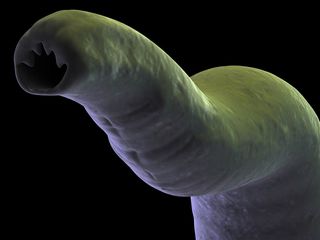
Swallowing Parasitic Worms May Heal Your Ails

Parasitic worms may be useful in treating lung disease and healing wounds, according to a study published online today (Jan.15) in Nature Medicine.
Although far from benign — these intestinal parasites infect more than a billion humans worldwide and kill or sicken hundreds of millions of people yearly — the worms appear to trigger key elements of the immune system responsible for repairing damaged tissues and reducing inflammation.
These live worms could be used someday in a controlled setting to treat serious lung injury caused by respiratory infections, such as pneumonia, according to the senior author on the report, William Gause of the University of Medicine and Dentistry of New Jersey in Newark, N.J.
What doesn't kill you ...
Gause and his colleagues studied a worm in rodents called Nippostrongylus brasiliensis, similar to a specific hookworm that infects more than 700 million humans, largely in developing countries. The life cycle of both N. brasiliensis and the hookworm is a fantastic voyage:
They enter the host's body when skin, often on the feet, comes in contact with worm larvae in feces-contaminated mud or water. The larvae travel through the circulatory system to the lungs; burrow out through the trachea, or windpipe; get swallowed down the esophagus; and then make their way through the stomach to the small intestines, where they mature into worms and propagate furiously, producing millions of eggs. [Tales of Bizarre Parasites]
The worse damage from the worms is to the lungs. As such, over the course of human (and rodent) evolution, the body has developed unique ways to minimize the harm done by hookworms and their like.
Sign up for the Live Science daily newsletter now
Get the world’s most fascinating discoveries delivered straight to your inbox.
Tickling the immune response
Gause's team found proteins in the immune system called cytokines that help to oust intestinal worms in mouse lungs and also initiate a cascade of healing. They do so by mobilizing various elements of the immune system to reduce inflammation and clear infectious debris while simultaneously stimulating so-called growth-factor steroids and other proteins to quickly repair the damaged lung tissue.
That initial cytokine action is called a Th2 response, so named because it involves immune system white blood cells called Type 2 helper T cells. The researchers' main findings are that the Th2 response has secondary, potent acute wound-healing effects and that worms can trigger it.
Gause said that what occurs in mice from N. brasiliensis perhaps occurs in humans exposed to parasitic worms. If so, these worms could be more effective than some drugs at triggering the immune response to cure the body from within.
"This orchestrated enhanced wound-healing response, which includes control of harmful inflammation and direct mediation of wound repair, may have evolved in the host to mitigate harmful effects of the considerable acute tissue damage these large multicellular parasites can cause as they migrate through essential organs," Gause told LiveScience. "In this regard, these parasites or parasite products may potentially be used to treat acute lung injury."
Worm therapy
The use of helminths, or parasitic worms, to treat immune disorders is called helminthic therapy, and it is not new. Promising studies are underway using live worms to treat several inflammatory diseases and autoimmune disorders such as Crohn's disease. These studies involve non-human parasites, most commonly Trichuris suis, a type of whipworm in pigs.
Helminthic therapy builds upon the hygiene hypothesis, which states that a decrease in the exposure to worms, bacteria and other parasites in developed nations has led to an increase in autoimmune disorders such as allergies and asthma.
Gause's work adds a new twist to helminthic therapy, moving it into the realm of wound healing and tissue repair. In addition to further studying the effects of live worms on mice and humans, Gause said his group would also try to isolate the parasite products that may actively enhance the wound-healing process.
Christopher Wanjek is the author of the books "Bad Medicine" and "Food At Work." His column, Bad Medicine, appears regularly on LiveScience.

Christopher Wanjek is a Live Science contributor and a health and science writer. He is the author of three science books: Spacefarers (2020), Food at Work (2005) and Bad Medicine (2003). His "Food at Work" book and project, concerning workers' health, safety and productivity, was commissioned by the U.N.'s International Labor Organization. For Live Science, Christopher covers public health, nutrition and biology, and he has written extensively for The Washington Post and Sky & Telescope among others, as well as for the NASA Goddard Space Flight Center, where he was a senior writer. Christopher holds a Master of Health degree from Harvard School of Public Health and a degree in journalism from Temple University.
Most Popular



